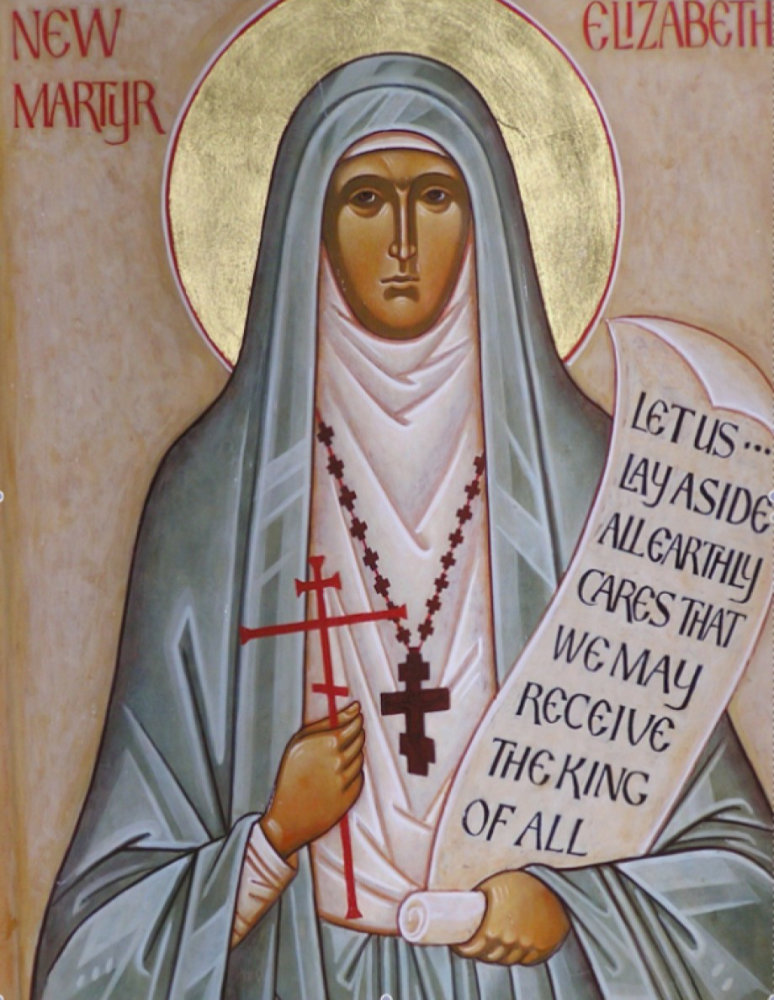St Elizabeth, the New Martyr
In 1864, a second daughter, Elizabeth, was born to the Grand Duke of Hesse-Darmstadt and Princess Alice, a daughter of Queen Victoria. The young princess grew up to be very beautiful, and at the age of nineteen, married a Grand-Duke of Russia, Sergei Alexandrovich.
Through Elizabeth’s marriage, her sister Alexandra was to meet and marry another Russian, the future Tsar Nicholas II. On moving to Russia to live with her husband, Elizabeth, who had always loved God, was soon drawn to Orthodox Christianity, intuitively perceiving the deep spirituality of the Russian Orthodox Church. Sorrowfully accepting the disapproval of her Lutheran relations, she converted in 1891.
In 1905, as civil unrest grew in Russia, Elizabeths husband was blown to pieces in an explosion by an anarchist assassin. Amazingly, the day after the murder, Elizabeth went to the prison and forgave the murderer, fervently urging him to repent of his crime. To the complete incomprehension of those around her she even tried, albeit unsuccessfully, to secure him a reprieve from execution. The tragedy was a turning point in Elizabeths life. Her husbands death was a solemn reminder of the fragility of all human life, and she abandoned completely the luxurious life of a royal dignitary.
After much prayer and soul-searching, she decided to found a monastic community, the convent of Sts Martha and Mary at her estate in Moscow. The convent, which opened in 1909, was funded by the sale of all her precious jewels. It was a place of prayer and practical service, with two churches, a hospital and dispensary, lodging house, orphanage, library and soup kitchen. The sisters also worked with the poor and sick in the slums of Moscow. Elizabeth lived a very self-denying lifestyle, eating only bread and vegetables, and always rising in the middle of the night to pray, and to check her patients, so that she never had much of a chance to rest herself.
The Russian Revolution in 1917 led to a terrible persecution of Christians. Churches and monasteries were destroyed and priests, monks and nuns tortured and killed. Against the advice she was given, Elizabeth chose to stay in Russia, and to face the inevitable fate of an abbess and member of the royal family- martyrdom. This came the following year, when she was imprisoned at Alapayevsk with other members of the aristocracy. One of the novices, Sister Barbara, would not leave her spiritual mother and stayed with the abbess despite being warned of the consequences. Thus Barbara chose death rather than desertion.
After four months on 5 July 1918, the night after the murder of the Tsar and his family, the prisoners were thrown into a shaft at a disused iron mine. None of them were killed by the fall, but were preserved by God to audibly sing hymns. Even the attempts of the soldiers to finally end their lives using hand grenades were unsuccessful, and the singing continued for some time, despite burning brushwood being thrown down the shaft.
When the bodies were recovered a few days later by the White Army, Elizabeths was found to be incorrupt, the fingers placed together in the traditional position for making the Sign of the Cross. One of the other prisoners, John, was found beside her with her monastic veil wrapped around his injured head as a bandage. By this, the former grand duchess expressed her love and care for others, even in the last moments of her earthly life.
Abbess Elizabeths remains, along with those of Sister Barbara, are still partially incorrupt to this day, and are preserved in the church of St Mary Magdalene in Gethsemane, Jerusalem. The relics have worked, and continue to work, numerous miracles. In 1981, because of St Elizabeth’s exemplary life of Christian service, sacrifice and forgiveness, her holy martyrdom and the clear evidence of her prayer and heavenly help, the Russian Orthodox Church Outside Russia declared Elizabeth, together with Barbara and all the other New Martyrs, to be saints.
